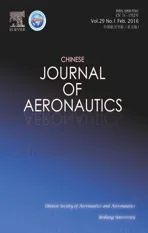Progress of continuously rotating detonation engines
2016-11-21ZhouRuiWuDanWangJianping
Zhou Rui,Wu Dan,Wang Jianping
Center for Combustion and Propulsion,College of Engineering,Peking University,Beijing 100871,China Center for Applied Physics and Technology,Peking University,Beijing 100871,China
State Key Laboratory for Turbulence&Complex Systems,Peking University,Beijing 100871,China
1.Introduction
Combustion is the sequence of exothermic chemical reactions between a fuel and an oxidant accompanied by the production of heat and conversion of chemical species.It is an important process in propulsion systems.Through chemical reactions,it converts the chemical energy of fuels into the heat and then the kinetic energy of the working medium to provide thrust.
Combustion can be performed in two different modes:de flagration and detonation.When the state of premixed combustible mixtures is changed,two Rayleigh lines of different slopes and one Hugoniot curve will be obtained,as shown in Fig.1(P-pressure,V-speci fic volume,A-initial state,U-upper Chapman–Jouguet(C–J)point,L-lower C–J point).The initial state of the premixed combustible mixture is at pointAand it may reach two different states after heat release,depending on the combustion mode.De flagration makes the gas state reach lower C–J point,while detonation makes it reach upper C–J point.During the de flagration process,the velocity of the combustion wave is of the order of meters per second,the pressure drops slightly and the speci fic volume expends signi ficantly.Thus de flagration is usually treated as approximately isobaric combustion.For detonation,its propagating velocity can reach the order of kilometers per second.During the combustion process,the combustion wave is tightly coupled with the shock wave,the pressure and temperature increase abruptly,and the speci fic volume decreases slightly.Thus detonation is often considered as approximately isochoric combustion.Obviously,the heat release of detonation is faster,the entropy increase of detonation is smaller,and the thermal ef ficiency of detonation is higher than that of de flagration.

Fig.1 Rayleigh lines and Hugoniot curve in P–V diagram.
Conventional aviation and aerospace engines,such as piston,turbine,turbofan,and ramjet engines,are usually based on de flagration.After one hundred years of development,it has become more dif ficult to achieve further improvements in such de flagration-based engines in terms of high ef ficiency.Since 1940s,more and more researchers have begun to focus on detonation-based engines to achieve higher thermodynamic ef ficiency of propulsion systems.Three kinds of detonationbased engines are most studied.They are standing detonation engine(SDE),pulse detonation engine(PDE)and continuously rotating detonation engine(CRDE).
In an SDE,detonation waves are positioned in the combustion chamber,normal or oblique to the wedge.Fuels are injected from the upstream of the inlet and then mixed with the supersonic air flow.After the pre-compression and preheat of shock waves,the combustible gas in the combustion chamber is detonated.Then the detonation products,after expansion,exhaust from the chamber to provide thrust.1SDE seems feasible in principle and it can avoid some bottlenecks that exist in the research of scramjet engines.However,it has encountered many technical problems in practical applications.For example,SDE can only work with the in flow of high Mach numbers(5–7).Due to its harsh restrictions on the flow conditions,detonation waves could not exist in the chamber stably for long duration and therefore the engine is easy to shut down.
PDE is most studied in the last three decades.It has four working processes,including fuel filling,detonation initiation and propagation,exhaust and scavenging.The thrust of PDE results from the pressure difference between the products,which are of high pressure,and the environment.In addition,the counter-acting force from the supersonic working medium also produces thrust.At present,the fundamental principles of PDE have been fully studied and experimental techniques have also been very mature.The high-frequency operations of dozens or even two hundreds hertz have been realized,and further research of PDE is focused on the increase of its effective thrust.2–6However,the entire operation of PDE is intermittent and periodic.It requires high-frequency initiations and each initiation needs high energy.Further,the thrust generated by PDE now is small.The problem is rooted in the working process of the engine itself.During the whole running process,the fuel filling and purging processes,which occupy 45%of the whole time,generate no thrust.6
In recent years,the most popular detonation-based engine is CRDE.It is also called rotating detonation engine(RDE)or continuous detonation wave engine(CDWE).It is of obvious advantages,compared with conventional engines or the other two detonation-based engines.Thus it is expected to bring technical revolution to current aviation and aerospace propulsion systems.In this paper,a survey of the development of CRDE is provided.The basic concepts and future applications are first introduced.And then signi ficant achievements in both experiments and numerical simulations are presented.In the last part,challenges that CRDE meets and needs to overcome are discussed.
2.Basic concepts and future applications of CRDE
2.1.Basic concepts
The combustion chamber of CRDE is usually a coaxial cylinder,as shown in Fig.2.The head end is closed but drilled with a large number of micro nozzles or slits to inject fuel and oxidant into the chamber.In experiments,the detonation wave in the chamber is usually initiated by a pre-detonator attached tangentially to the chamber.While working,one or more detonation waves lean on the head end and propagate in the circumferential direction.Behind the detonation wave,burnt products are of high temperature and high pressure.Through a series of expansion waves,these burnt products flow out of the downstream exit almost axially to provide thrust.In addition,there is an oblique shock wave and a contact surface in the flow field.During the propagating process of the detonation wave,combustible mixtures are continuously injected into the chamber.They form a triangle combustible mixture layer and are combusted by the detonation wave.

Fig.2 CRDE propagation schematic structure.
In comparison with other detonation-based engines,CRDE hasseveralinherentadvantages.First,itneedsonlyone-timeinitiation.Oncestarted,detonationwaveswillcontinuouslyrotate.Secondly,due to the self-sustaining and self-compression of detonation waves,combustible mixtures can be compressed inherently.Thus CRDE can produce a large effective thrust at lowpressureratio.Besides,thepropagationdirectionofdetonation waves is independent of the in flow and out flow directions,preventing the intermittent thrust.Detonation waves are enclosed in the combustion chamber to produce ef ficient working medium.It avoids the tremendous energy loss caused bytheejectionofdetonationwaves.Moreover,CRDEcanwork stably within a wide range of in flow velocity.Thus it also allows for a wild range of the flow rate of combustible mixtures.
2.2.Future applications
Based on the characteristics of CRDE and industrial needs,predictable propulsion systems will be rotating detonation rocket engine,rotating detonation ramjet engine and rotating detonation turbojet engine,as shown in Fig.3.They can be applied to various types of rockets,missiles,near space aircraft,military aircraft,unmanned aerial vehicles and so on.
Rotating detonation rocket engine is the simplest kind of CRDE.The early research of CRDE is based on gaseous fuel rocket engine model.Currently,rotating detonation rocket engine of liquid fuel has been successfully realized in Russia,Poland and other countries.The existing mature technologies of rocket engines can be ef ficiently transferred to the rotating detonation rocket engine.This favors the engineering applications of such kind of CRDE.
Compared with conventional ramjet,rotating detonation ramjet engine is not so sensitive to the in flow and can work stably in a wide range of flight conditions.Thus,the working range of ramjet will be widened in future,if detonation waves take the place of the de flagration waves in conventional ramjet.
The rotating detonation waves can also be applied in turbojet engines.Rotating detonation turbojet engine can produce a large effective thrust at low pressure ratio.This will reduce the number of compressors in conventional turbine engines and then reduce the demanding requirements of the turbine manufacturing process.The resulting combustion chamber is smaller,simpler,and of higher thrust/weight ratio.Due to the characteristic of detonation waves,the performance of such engines will be increased greatly as well.
3.Development of CRDE
3.1.Experimental studies
The basic concept of continuous detonation waves was proposed by Voitsekhovskiiin 1960.7,8Heexperimentally achieved a short-lived continuous detonation wave in a diskshaped chamber,using premixed acetylene and oxygen.The schematic of the experimental setup is shown in Fig.4(a).Premixed combustible mixtures were injected into the chamber along the inner cylinder of the disk.Burnt products exited from the chamber along the outer wall of the disk.Rotating detonation waves continuously propagated in the chamber.Based on the motion-compensated technology,a propagating and rotating detonation with six heads was observed,as shown in Fig.4(b).This experiment was considered as the first fundamental step in the history of CRDE.
Afterward,theoretical analyses and preliminary experimental research of the application of rotating detonations to rocket propulsion were first conducted by Adamson and Olsson9and Nicholls et al.10They pointed out that the new concept engine was expected to be applied to the rocket propulsion systems,although there were many questions to answer.In the experiments,Nicholls et al.10used an injection system in line with liquid rocket engines and tested several fuel–oxygen mixtures(including hydrogen,methane,acetylene and others).However,the detonation waves extinguished after one cycle and they could not stabilize for long duration.They pointed out that the injection pattern,advance ignition, flow control and other factors played a key role in the formation of a continuous detonation in experiments.
These early experimental researches mainly focus on the feasibility and initiation ofdetonation waves.Motioncompensated pictures are usually obtained to reveal the flow structure of continuous detonation waves.Long duration operations have not been achieved.Due to the limitations of measurements and numerical simulation,the propagating mechanism of stable detonation waves is less understood.In the following twenty years,little attention has been paid to the development of CRDE and few publications relate to CRDE.
In recent years,extensive experiments of CRDE have been carried out in the Institute of Hydrodynamics by Bykovskii et al.11–13in Russia.They achieved continuous liquid and gas fuel detonations of multi-cycle in combustors of different shapes under different injection systems.The basic geometric con figurations are shown in Fig.511.The tested fuel included acetylene,hydrogen,propane,methane,kerosene,gasoline,benzene,alcohol,acetone and diesel.The oxidant was air or gaseous oxygen and in some cases,liquid oxygen.Without tail nozzle,the speci fic impulse of CRDE using kerosene–oxygen mixtures in experiments was as high as 200 s.In addition,the compensation technique was used to capture the flow filed inside the CRDE combustion chamber.The results of stable rotating detonation waves are shown in Fig.611(1-fuel and oxidizer injection,2-annular duct,3-mixture,4-detonation wave,5-products,6-contavt discontinuity,7-oblique shock wave,8-product back flow,D-direction of the detonation propagation).

Fig.3 Applications of CRDE.
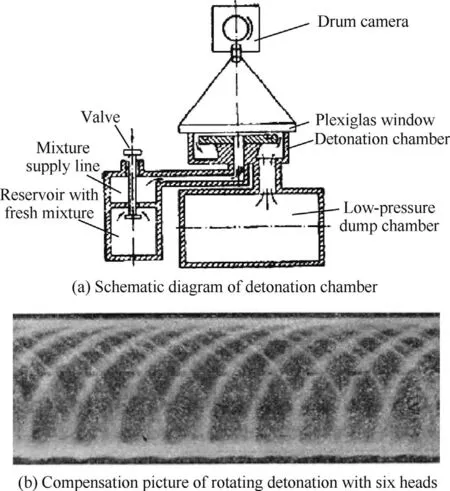
Fig.4 Experiment by Voitsekhovskii.8
They also proposed empirical laws for the parameters in the chamber design.11These parameters were of great signi ficance to achieve stable detonation waves.For example,the critical height of the mixture layer depthh*ahead of the detonation front was related to the detonation-cell size α ash*=(12 ± 5)α.The minimum length of chambers was approximated by the equationLmin=2h*.If the chamber length was smaller than this value,stable detonation waves would not be formed.The radial size of the chamber should not be smaller than one detonation-cell size.When liquid fuel was used,it should not be smaller than the minimum diameter of droplets.
With the increasing international cooperation,more and more researchers are involved in the experimental studies of CRDE.Extensive CRDE experiments have been carried out by Wolanski’s group14in Poland.Different geometries of cylindrical chambers,ranging from 50 mm to 200 mm in diameter,were tested with fuels of acetylene,hydrogen,methane,ethane,propane and kerosene with air,oxygen-enriched air,and oxygen under different injection stagnation pressures and back pressures.Long durations of stable detonation waves were obtained.The experimental devices and obtained pressure signals of CRDE are shown in Figs.7 and 8.14

Fig.6 Continuous rotating detonation wave structure in a cylindrical chamber obtained for different mixtures in experimental research by Bykovskii et al.11in Russia.
Combining experimental data and theoretical analysis,Wolanski et al.15proposed an equation to determine the detonation wave number inside the combustion chamber.Subsequently,they built a small model of a rocket engine,tested it and gradually optimized the design.Detonation waves of long duration were obtained and the performance of the engine(thrust and speci fic impulse)was measured.15In cooperation with Japanese researchers,Wolanski et al.16also proposed a new concept of Turbocharged CRDE,which was a combination of CRDE and ramjet.They applied for a Japanese patent on CRDE and a similar application was repeated for a US patent.The engine had several advantages,including high thermal ef ficiency,simple design,low charges and others.They believed that it had a bright prospect.

Fig.5 Basic geometric con figurations for continuously rotating detonation studies by Bykovskii et al.11in Russia.
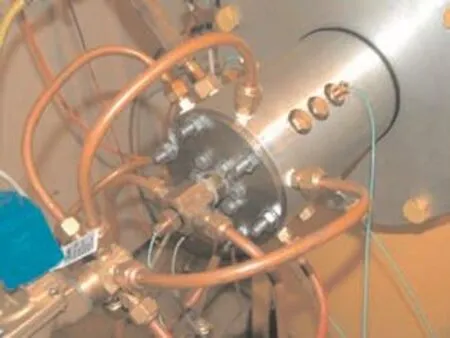
Fig.7 Experimental devices of CRDE in Wolanski’s lab in Poland.14

Fig.8 Experimental pressure signals of CRDE in Wolanski’s lab in Poland.14
Lately,Wolanski with Polish Aviation Institute17started the research of rotating detonation turbojet engine using gaseous mixtures.They replaced the combustion chamber of the conventional GTD-350 turbojet engine by that of continuously rotating detonation waves.The facility was built and its feasibility was proved.Now,research on optimization of the chamber under different operating conditions is underway.
The research team headed by Wang Jianping at Peking University was the first to conduct experimental studies of CRDE in China.In 2009,they successfully achieved hydrogen/oxygen rotating detonation waves and the propagating velocity was 2041 m/s.18Since then,they have carried out extensive researches of CRDE and achieved rapid progress.19–23They have tested several combustion chambers of CRDE,and one of them with a pre-detonation tube is shown in Fig.9.22

Fig.10 2 s pressure signals of rotating detonation waves.
Hydrogen/air and hydrogen/oxygen rotating detonation waves were obtained as long as 2 s in their group,as shown in Fig.10,which is limited by the bearing of the pressure transLducers.They have also observed several interesting phenomena and proposed related explanations.For example,Wang et al.22found that a tangential flow of fresh gas from the pre-detonator would lead to a main detonation wave and a few detonation wavelets,and furthermore,slow down the detonation wave.Liu et al.23found oscillation phenomenon in pressure peaks and they also proposed a self-adjusting mechanism to explain the phenomenon,as shown in Fig.11.Now,they are trying to explore the propagating mechanism of stable detonation waves and evaluate the propulsive performance of RDE quantitatively by means of experiments.
In recent years,many countries are also interested in the prospect of CRDE and have funded the research in this area.This makes CRDE develop from conceptual phase to the stage of engineering applications.MBDA-France in Europe performed some theoretical and experimental studies.24They designed a full-size model of the engine and performed ground test.25In 2011,MBDA-France announced a concept of Perseus supersonic missile system,they noted,‘The new continuous detonation ramjet engine has greatly enhanced the performance of the supersonic missile”26.They compared the new missile with the BrahMos missile.It was estimated that the new missile could reduce the launch mass from 3000 kg to 800 kg and decreased the body length from 8.4 m to 5 m.They also announced that Perseus supersonic missile was expected to enter the force in 2030.
Center National de la Recherche Scienti fique(CNRS)in France performed experimental researches of CRDE at Laboratory of Combustion and Detonation(LCD).27The schematic diagram of the combustion chamber and experimental devices are shown in Fig.12.They obtained stable pressure signals measured by the pressure transducer.Using the highspeed camera,several detonation waves were observed in the combustion chamber,as shown in Fig.13.They also pointed out that the number of detonation waves adjusted itself automatically to the mass flow of propellants.As the mass flow increased,there were more detonation waves in the combustion chamber.

Fig.9 Experimental devices of CRDE in Wang’s lab at Peking University in China.22

Fig.11 Experimental result and analysis by Liu in Peking University.23
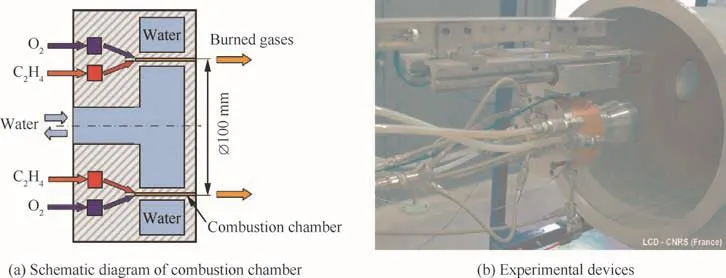
Fig.12 Experimental schematic diagram and devices at CNRS in France.27

Fig.13 Rear-view of CRDE with high-speed camera at CNRS in France.27

Fig.14 Experimental facilities of CRDE and its combustion chamber at AFRL in USA.28
Several groups in USA are also carrying out experimental studies of CRDE.Air Force Research Laboratory(AFRL)cooperates with Universities to research CRDE.28–30The combustion chamber is still coaxial cylinder,as shown in Fig.14.They performed experiments in chambers of different sizes.Hydrogen/air and ethylene/air were used.The engine was tested at a wide range of flow rates and equivalence ratios.The high-speed camera used in experiments captured images of multi-detonation wave in the combustion channel.Pressure signals were traced and the detonation velocity was calculated.In addition,an optically accessible CRDE,with the quartz tube as the outer wall of the chamber,was developed to make basic measurements of an operating CRDE flow field.With the high-speed camera,the basic flow structure of the rotating detonation and its entire propagating process were determined.31The optically accessible CRDE and the obtained flow field are shown in Fig.15.

Fig.15 Experimental device and result in AFRL.31
Since 2010,Pratt and Whitney Rocketdyne(PWR)has been investigating the behavior of a CRDE using modular hardware.32Continuous detonation was achieved for long duration with multiple propellants and engine geometries.The longest test was 6.95 s.Based on experimental data,the combustion chamber was optimized.High-speed camera and pressure transducer were used to understand detonation wave behavior.The experimental facilities of CRDE is shown in Fig.16.

Fig.16 Experimental facilities of CRDE at PWR.32
CRDE experiments have also been carried out by GHKN/Aerojet in USA.33In their cooperation,Aerojet tested CRDE and invested in test facility.The experimental facilities of CRDE at GHKN are shown in Fig.17.Currently,their research is still at the early stage.Experimental researches of CRDE have also been done at Texas State University in USA.The injection and ignition processes were focused on in experiments.They effectively controlled the propagating direction of detonation waves in ignition process.34Liu et al.35,36,from National University of Defense Technology in China,have tested the feasibility of CRDE experimentally.In their experiments,a pre-detonation tube was used to ignite the engine.It was found that there existed a time gap between the initiation and the formation of stable detonation waves due to the exhaust process of the pre-detonation tube.Thus deep understanding of the initiation is needed to enhance the stability of detonation waves.In experiments,they achieved continuously rotating detonation waves of long duration,and the corresponding pressure signals are shown in Fig.18.Zheng et al.37,from Nanjing University of Science and Technology in China,also realized hydrogen/air rotating detonation waves.The equivalence ratio was 0.93,and the tested velocity ofdetonation waves isfrom 1518.5 to 1606.1 m/s.Peng et al.38,also from Nanjing University of Science and Technology in China,did ignition experiments on rotating detonation engine with the slot-ori fice impinging injection method.It was found that the success rate of rotating detonation wave initiation was up to 94%with automotive spark plug.
3.2.Numerical studies
Because of the properties of detonation waves which are of high velocity,high temperature and high pressure,it is dif ficult to obtain the detailed flow field and physical or chemical parameters of CRDE.In the early numerical research of CRDE,detailed and large-scale calculations of detonation waves were not performed,since computer power at that time was signi ficantly less than today’s computers and also because the shock-capturing schemes was not as high as today’s.Thus,many simplifying assumptions had to be made.Despite of all these limitations,Shen and Adamson39performed calculations of CRDE combining both theoretical and numerical methods,and the basic structure of rotating detonation waves was revealed,as shown in Fig.19.
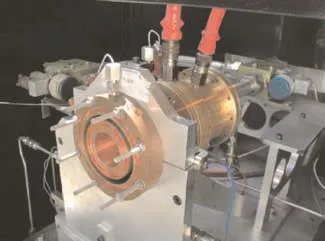
Fig.17 Experimental facilities of CRDE at GHKN.33

Fig.18 Experimental results of CRDE at National University of Defense Technology.35
Numerical simulations of CRDE in different geometries and for different initial conditions offer a very good tool not only for better understanding of the mechanisms controlling the detonation propagation process in complex geometries but also for optimizing the geometry and fuel and oxidizer feed parameters for the experimental design of CRDE.In recent years,detailed simulations of the flow field structure in the combustion chamber of CRDE have been performed due to the increasing computing power and the rapid development of the program parallelization.Now,numerical simulation has been a powerful means to assist and guide experimental research.
Zhdan et al.40,41in Russia performed early theoretical analysis and 2D numerical simulations of continuously rotating detonation waves.The obtained flow fields qualitatively coincided with the experimental results,as shown in Fig.20of the combustion chamber).However,the calculated detonation velocity was only 80%of the theoretical Chapman–Jouguet(C–J)value.Due to the simple numerical methods and coarse meshes,only rough flow field structures were obtained.

Fig.19 Basic flow structure of CRDE by Shen and Adamson.39

Fig.20 Numerical results by Zhdan et al.in Russia.40
Hishida et al.42in Japan,using two-step reaction chemical model,obtained detailed structures of the detonation flow field by assuming the 3D cylindrical chamber to be a 2D plan without variation in radical direction and with periodic boundary conditions in circumferential direction,as shown in Fig.21.They obtained the cellular pattern of the rotating detonation wave on the computed smoke-foil record.For the first time,they analyzed the Kelvin–Helmholtz instability existing on the interface of the injected combustible.The propulsive performance of CRDE was also computed,and the speci fic impulse was as high as 4700 s.
The research team headed by Wang Jianping, from PekingUniversity in China, has begun both 2D and 3D CRDE simulationssince 2007. They were the first who performed both 2Dand 3D simulations of CRDE to validate RDE’s feasibilityand explore its physical mechanism. Thorough and comprehensiveresearches on RDE have been done from manyaspects, including the detailed flow structure, fuel injectionlimit, nozzle effects, viscous effects, propulsive performance,self-ignition, particle path, thermodynamic performance,shock reflections near the head end, and the generation andpropagation process of multi-detonation waves.43–53
In 2010, Shao et al.43have already obtained 3D flow field ofCRDE, as shown in Fig. 22(a). Based on 3D simulations, Shaoet al.44,45verified the unique advantages of continuous detonationwaves, that rotating detonation waves can be realizedwithin the range from subsonic to hypersonic injection, andalso found that the combustor with Laval tail nozzle had thebest performance. Mach number contours in Laval nozzlecombustor is shown in Fig. 22(b). Liu et al.46–48establisheddifferent new intake models to analyze their effects on the flowfield evolution and the stability of detonation waves. For thefirst time, they captured the phenomenon of the spontaneousformation of multi-front rotating detonation waves in thecombustion chamber of CRDE, as shown in Fig. 22(c). Tanget al.49proposed a new model of CRDE without inner cylinderand verified the feasibility of this new model numerically, theflow field of which is shown in Fig. 22(d). If the new modelis used in application, it can greatly reduce the difficulties inengine cooling. Zhou et al.50,51proposed particle trackingmethod to track flow particles in the flow field and found thatflow particles spurt out the combustor almost axially. Theyalso discussed the corresponding thermodynamic cycle andverified the superior performance of CRDE. Wu et al.52,53discussedthe stability and restabilization of CRDE, and foundthat CRDE could finish the main adjustment within two timesof the detonation cycle period, demonstrating the high stabilityof CRDE.
Yi et al.54–56in Singapore,using one-step chemical reaction model of H2/Air,performed both 2D and 3D CRDE simulations.They mainly focused on estimation of various design parameters on the propulsive performance of CRDE.These parametric variables included stagnation pressure,stagnation temperature,injection area ratio,axial chamber length effects and the number of detonation waves.It was shown that the propulsive performance of the engine was strongly dependent on the injection conditions,but was weakly dependent on the axial chamber length effects and the number of detonation waves.They also investigated the effect of tail nozzle angle and length on the propulsive performance of CRDE,and gave the nozzle design parameters for optimal performance.55
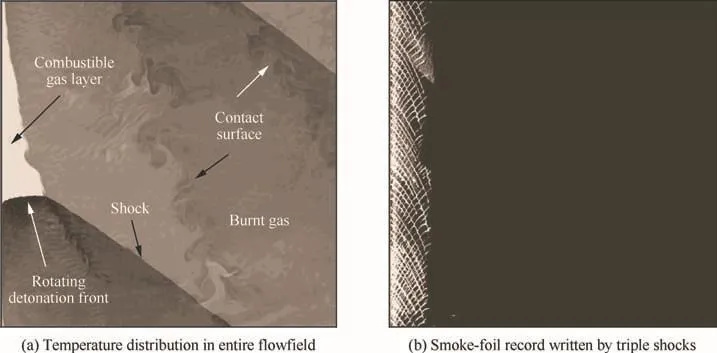
Fig.21 Detailed 2D flow structure of CRDE in numerical results by Hishida in Japan.42
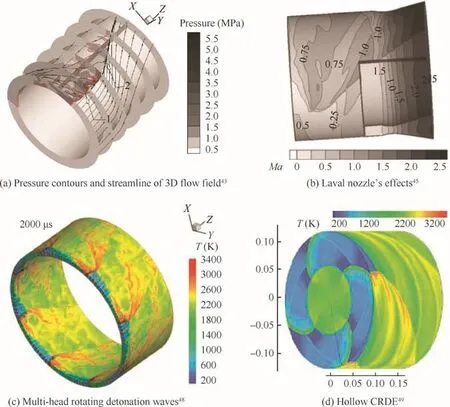
Fig.22 Numerical results of CRDE at Peking University.
Davidenko et al.57in France performed 2D CRDE simulations,as shown in Fig.23(a).Combined with theoretical analysis,they showed that CRDE had a signi ficant advantage over the conventional rocket engine in terms of cycle work and speci fic impulse.Moreover,they have also done 3D simulations and used the adaptive mesh re finement(AMR)method to increase the computation ef ficiency.They compared 3D results to that of 2D.The overall flow field in 2D and 3D simulations was similar to each other.However,the 3D flow had speci fic features due to the effects of the inner and outer cylindrical wall on detonation waves,as shown in Fig.23(b).58
Based on 2D numerical results,Hayashi et al.59and Yamada et al.60in Japan discussed the threshold of detonation limit from three aspects:the computational area,the ignition energy and the injection parameters.The results showed that there were no stable detonation waves when the computational area was smaller than the lower limit.However,as for the upper limit,there was no such unstable phenomenon.They also pointed out that both upper and lower limits existed in the injection stagnation pressures.Beyond the two limits,no stable detonation waves formed,either.Tsuboi et al.61in Japan,using detailed reaction model for hydrogen/oxygen,systematically analyzed the differences of the flow field structure and performance parameters between 2D and 3D CRDE simulations.Without the contraction tail nozzle,the speci fic impulse and thrust in 3D simulation are close to those in 2D simulation under the same conditions.With the contraction tail nozzle,the speci fic impulse and thrust in 3D simulation will be increased.

Fig.23 Flow field of 2D CRDE by Davidenko et al.57and 3D CRDE by Eude et al.58in France.
Uemura et al.62in Japan,using detailed reaction model,simulated the flow fields of a small size combustion chamber in a subtle way.Their numerical results showed that there were several transverse waves at the detonation front,as shown in Fig.24.They found out that at the interaction point between the detonation front and the oblique shock wave,an unreacted gas pocket appeared and ignited periodically to generate transverse waves.The generated transverse waves propagated toward the inlet wall and then bounced back to the interaction point to maintain detonation propagation.Although fine detonation flow field structures were obtained,their research mainly focused on the micro-wave structures.The combustion chamber size is of the order of millimeter and quite different from the practical applications.Tsuboi et al.63from the same group,also using detailed reaction model,estimated the thrust performance on CRDE.They used both 2D and 3D numerical simulations to determine the effects of the CRDE parameters and the dimensional effects on the thrust performance under a low-pressure environment.

Fig.24 Transvers waves at detonation front in numerical results by Uemura et al.in Japan.62
Kailasanath and Schwer,from U.S.Naval Research Laboratory,have performed numerical simulations of CRDE since 2011.64–67They have numerically obtained typical flow field of rotating detonation waves and have systematically investigated several different aspects of CRDE.These included the effects of the stagnation pressure,back pressure,combustion chamber size,different fuels,injection fill region and exhaust plenum on the flow field and performance of CRDE.In the previous simulations,the effects of the upstream mixture plenum on detonation waves are not concerned.To clarify the effects in detail,they made new attempts and created several more practical injection systems68,69,as shown in Fig.25.They have studied the effects of pressure feedback into the upstream mixture plenum.They also examined the effects of these different injector con figurations on the stability of detonation waves and the performance of CRDE.These results provide technical support for the design of the chamber head in experiments.
In addition,Schwer and Kailasanath70also investigated exhaust effects on the flow field and performance of CRDE.The computational domain and the results are shown in Fig.26(1 atm=101325 Pa).The results suggested that including an exhaust plenum had only a slight effect on the performance measurement and general flow field characteristics within the CRDE.Thus,the previous simulation of CRDE without an exhaust plenum is valid and reliable.
Lu et al.71,from University of Texas at Arlington in USA,provided an assessment of the challenges of CRDE.They developed a cycle analysis model for an airbreathing CRDE and analyzed the effects of the flight Mach number on its propulsive performance.72Moreover,they made a performance comparison between airbreathing PDE and airbreathing CRDE and also a performance comparison between airbreathing CRDE and rocket-mode CRDE.In their simulations,an airbreathing CRDE,using hydrogen as fuel,reached a speci fic impulse of 3800 s.The speci fic impulse was 1500 s when propane was used as fuel.73

Fig.25 Numerical results of CRDE with different injectors by U.S.Naval Research Laboratory.68

Fig.26 Numerical results of CRDE with an exhaust plenum by U.S.Naval Research Laboratory.70
Stoddard and Gutmark74,from University of Cincinnati in USA,performed 3D simulations of centerybodyless CRDE.UnlikeTang etal.49,they used a Reynolds-Averaged Navier–Stokes(RANS)computational fluid dynamics(CFD)program Fluent by ANSYS and a Spalart–Allmaras turbulence model to better simulate mixing of hydrogen and air.The feasibility of CRDE without inner wall under nonpremixed injection was validated,and the effect of various alterations was studied,including hydrogen injection hole size alteration,longitudinal walls,and an ejector.
Folusiak et al.75and Swiderski et al.76,from space technologies center institute of aviation in Poland,performed numerical studies on CRDE,using unstructured grid.The computational model is quite similar to experimental devices in their lab,as shown in Fig.27(DW-large scale structure of the detonation wave,IP-injection plane location,SW-shock wave propagating downstream).Due to the simple shockcapturing scheme and large grid size,they did not obtain fine flow field structures.However,their numerical results provided a quantitative reference for experimental researches.
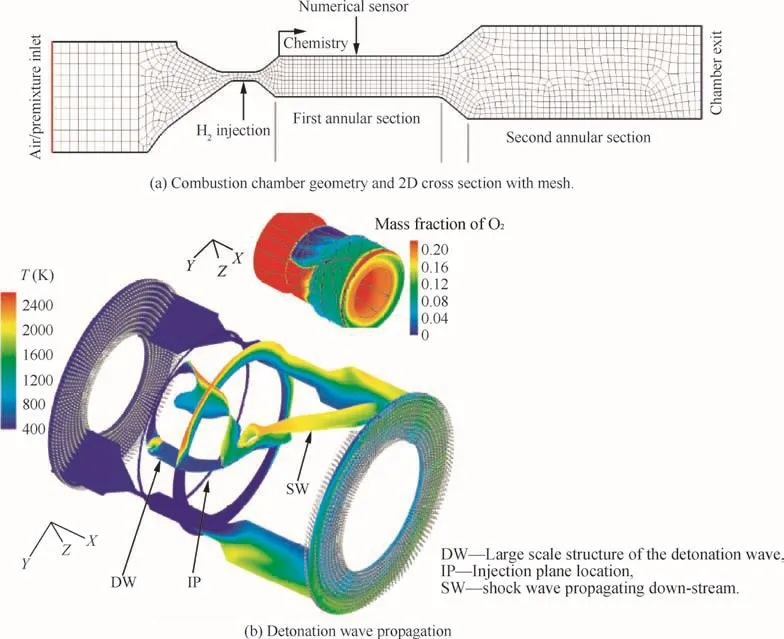
Fig.27 Computational model and flow field of CRDE in numerical work by Folusiak et al.75and Swiderski et al.76in Poland.

Fig.28 Physical model and flow field of CRDE in numerical work by Frolov et al.77in Russia.
Frolov et al.77in Russia performed 3D simulations of CRDE with separated supply of hydrogen and air.The physical model of CRDE and the main operation parameters were the same as those of the experimental setups at Lavrentyev Institute of Hydrodynamics(LIH),as shown in Fig.28(a).The numerical results successfully showed the non-premixed burning process of detonation waves,as shown in Fig.28(b).The obtained flow field coincided with experimental observation by Bykovskii et al.13However,in contrast to these experiments,in which two or three detonation waves traveling in the combustion chamber were observed,the calculations under the same conditions predicted stable operation mode with only one detonation wave.These discrepancies between the calculation results and experimental data require further studies.Sustainable and ef ficient mixing of fuel and oxidant has been an iTmh pe onrut amnetr p icr aelr er q esu u i sl t i ts e b f y o rF r t ho el o s v t ae bt lael .d7e7tpornoavt ii od ne d p q r ou pa n a gt iat ati toi vne.data to examine the mixing process and the mixing degree of fuel P a a nn de t o xa il d.7a8na tt. Nanjing University of Science and Technology in China also performed numerical simulations on continuously rotating detonation waves and obtained the overall flow field.
4.Challenges of CRDE
Although signi ficant progresses of CRDE have been achieved in recent years,there are still many issues that need further exploration.
(1)Injecting and mixing mechanism of fuels and oxidants
Suf ficient mixing is required for all combustion processes,especially for CRDE.In practice,the mixing must happen rapidly and in a short distance to sustain detonation waves.These requirements are exacerbated by the high mass flow rates of CRDE,the rapid propagating velocity of detonation waves,and the high-pressure detonation products.Therefore,it needs to further clarify the intake way,the mixing mode and the blending process of fuel and oxidant.At present,most numerical simulations are based on the ideal injection model in which combustible mixtures are stoichiometric premixed.In the future,simulations of CRDE should be carried out under non-premixed and different equivalence ratio conditions.
(2)Characteristic and performance of rotating detonation waves with different fuels and oxidants
Currently,gaseous hydrogen is usually used as fuel in simulations.However,the gaseous mixtures are unrealistic in practical applications.It is necessary to research the appropriate equivalence ratio range of different fuels and oxidants in depth,within which rotating detonation wave can be formed.Numerical simulations can be helpful to determine quantitatively the propulsive performance of CRDE with different fuels and oxidants.
5.Conclusions
In recent years,stable continuous detonation waves of long duration have been successfully achieved using a variety of fuels in combustion chamber of different structures under various injection modes for experimental research.Preliminary thrust and speci fic impulse of CRDE have been measured.Usually,pressure transducers are used to record the pressure signal and compensation technique and high-speed camera are used to capture the flow field inside the combustion chamber of CRDE.In numerical simulations,detailed flow field structures are obtained.And the effects of injection conditions,intake models and chamber geometries on the flow field structure and propulsion performance of CRDE have been thoroughly studied.These numericalresults are in good agreement with the experimental data.Combined with theoretical analysis,thermodynamic cycle of continuous detonation has been numerically researched.Network and thermal ef ficiency of CRDE have been quantitatively calculated.The superiority of CRDE’s performance has been veri fied.Currently,the engineering application of CRDE has also been gradually carried out.Reliable prototype of CRDE is expected to be built in the near future.
Although rich experience related to CRDE has been gained and the many characteristics of CRDE have been mastered,there are still more questions than answers at present.This requires international collaboration among worldwide scholars.CRDE is expected to bring good prospects for military applications and the relevant agencies should pay attention and offer support to its development.
Acknowledgements
This study was co-supported by the Aeronautical Science Foundation of China(No.2008ZH71006),the National Natural Science Foundation of China(No.91441110)and the Aerospace Innovation Fund of China(No.SY41YYF2014009).
1.Ashford SA,Emanuel G.Oblique detonation wave engine performance prediction.J Propul Power1996;12(2):322–7.
2.Bussing T,Pappas G.An introduction to pulse detonation engines.32ndaerospacesciencesmeeting&exhibit;1994 Jan 10–13,Reno,NV,USA.Reston:AIAA;1994.p.1–8.
3.Ma FH,Choi JY,Yang VG.Propulsive performance of airbreathing pulse detonation engines.J Propul Power2006;22(6):1188–203.
4.Kasahara J,Hasegawa A,Nemoto T,Yamaguchi H,Yajima T,Kojima T.Thrust demonstration of a pulse detonation rocket‘TODOROKI”.43rd AIAA/ASME/SAE/ASEE joint propulsion conference&exhibit;2007 July 8–11,Cincinnati,OH,USA.Reston:AIAA;2007.p.1–14.
5.Kailasanath K.Research on pulse detonation combustion systems–a status report.47th AIAA aerospace sciences meeting including the new horizons forum and aerospace exposition;2009 Jan 5–8,Orlando,Florida,USA.Reston:AIAA;2009.p.1–21.
6.Kawai S,Fujiwara T.Numerical analysis of 1st and 2nd cycles of oxyhydrogen PDE.40th aerospace sciences meeting&exhibit;2002 Jan 14–17,Reno,Nevada,USA.Reston:AIAA;2002.p.1–8.
7.Voitsekhovskii BV.Stationary spin detonation.Sov J Appl Mech Tech Phys1960;3:157–64(in Russian).
8.Voitsekhovskii BV,Mitrofanov VV,Topchian ME.Structure of the detonation front in gases.Combust Explos Shock Waves1969;5(3):267–73.
9.Adamson TCJ,Olsson GR.Performance analysis of a rotating detonation wave rocket engine.Astronaut Acta1967;13(4):405–15.
10.Nicholls JA,Cullen RE,Ragland KW.Feasibility studies of a rotating detonation wave rocket motor.J Spacecraft Rockets1966;3(6):893–8.
11.Bykovskii FA,Zhdan SA,Evgenii FV.Continuous spin detonations.J Propul Power2006;22(6):1204–16.
12.BykovskiiFA,VedernikovEF.Continuousdetonationofasubsonic flowofapropellant.CombustExplosShockWaves2003;39(3):323–34.
13.Bykovskii FA,Zhdan SA,Vedernikov EF.Continuous spin detonation of a hydrogen-air mixture with addition of air into the products and the mixing region.Combust Explos Shock Waves2010;46(1):52–9.
14.Kindracki J,Wolanski P,Gut Z.Experimental research on the rotating detonation in gaseous fuels–oxygen mixtures.Shock Waves2011;21(2):75–84.
15.Wolanski P.Rotating detonation wave stability.23rd international colloquium on the dynamics of explosions and reactive systems;2011 July 23–29;Irvine,USA.USA:23ICDERS;2011.p.1–10.
16.Tobita A,Fujiwara T,Wolanski P,inventor.Detonation engine and flying object provided there with publication data.United States patent US 7784267.2010 Aug 31.
17.WolanskiP.Detonation propulsion.ProcCombustInst2013;34:125–58.
18.Wang JP,Shi TY,Wang YH,Liu YS,Li YS.Experimental research on the rotating detonation engine.The 14th shock wave and shock tube conference;2010 July 14–16;HuangShan,China,2010.p.181–4 in Chinese.
19.Wang YH,Wang JP,Shi TY,Liu YS.Experimental research on transition regions in continuously rotating detonation waves.48th AIAA/ASME/SAE/ASEE joint propulsion conference&exhibit;2012 July 30–August 1,Atlanta,Georgia,USA.Reston:AIAA;2012.p.1–12.
20.Wang YH,Wang JP,Liu YS,Li Y.Experimental investigation on continuously rotating detonation engines.The 2013 asia-paci fic international symposium on aerospace technology;2013 Novermber 20–22,Takamatsu,Japan.Takamatsu:APISAT;2013.p.1–10.
21.Wang YH,Wang JP,Shi TY.Discovery of breathing phenomena in continuously rotating detonation.Proc Eng2013;67:188–96.
22.Wang YH,Wang JP,Li YS,Li Y.Induction for multiple rotating detonation waves in the hydrogen–oxygen mixture with tangential flow.Int J Hydrogen Energy2014;39(22):11792–7.
23.Liu YS,Wang YH,Li YS,Li Y,Wang JP.Spectral analysis and self-adjusting mechanism for oscillation phenomenon in hydrogen–oxygen continuously rotating detonation engine.Chin J Aeronaut2015;28(3):669–75.
24.Falempin F,Daniau E,Getin N,Bykovskii FA,Zhdan S.Toward a continuous detonation wave rocket engine demonstrator.14th AIAA/AHI space planes and hypersonic systems and technologies conference;2006 Nov 6–9,Canberra,Australia,USA.Reston:AIAA;2006.p.1–11.
25.Francois F,Emeric D.A contribution to the development of actual continuous detonation wave engine.15th AIAA international space planes and hypersonic systems and technologies conference;2008 April 28-May 1;Dayton,Ohio,USA.Reston:AIAA;2008.p.1–13.
26.He XH.MBDA’s announcement of Perseus supersonic missile system.Winged Missiles J2012;2:3–6.
27.Lentsch A,Bec R,Serre L,Falempin F,Daniau E,Piton D,Prigent E,Canteins G,Zitoun R,Desbordes D,Jouot F,Gokalp I.Overview of current French activities on PDRE and continuous detonation wave rocket engines.AIAA/CIRA 13th internatinal space planes and hypersonics systems and technologies;2005 May 16–20,Capua,Italy.Reston:AIAA;2005.p.1–13.
28.Shank JC,King PI,Karnesky J,Schauer FR,Hoke JL.Development and testing of a modular rotating detonation engine.50th AIAA aerospace sciences meeting including the new horizons forum and aerospace exposition;2012 Jan 9–12,Nashville,Tennessee,USA.Reston:AIAA;2012.p.1–10.
29.Russo RM,King PI,Schauer FR,Thomax LM.Characterization of pressure rise across a continuous detonation engine.47th AIAA/ASME/SAE/ASEE joint propulsion conference&exhibit;2011 July 31–August 3,San Diego,California,USA.Reston:AIAA;2011.p.1–12.
30.Suchocki JA,Yu SJ,Hoke JL,Naples AG,Schauer FR,Russo R.Rotating detonation engine operation.50th AIAA aerospace sciences meeting including the new horizons forum and aerospace exposition;2012 Jan 9–12,Nashville,Tennessee,USA.Reston:AIAA;2012.p.1–10.
31.Naples A,Hoke J,Karnesky J,Schauer F.Flow field characterization of a rotating detonation engine.51st AIAA aerospace sciences meeting including the new horizons forum and aerospace exposition;2013 Jan 07–10,Grapevine,Texas,USA.Reston:AIAA;2013.p.1–6.
32.Cla flin S.Recent progress in continuous detonation engine development at Pratt& Whitney Rocketdyne.International workshop on detonation for propulsion;2012 September 1–3,Tsukuba,Japan.Kokyo:IWDP;2012.p.1–9.
33.Smith R,Siebenhaar A.Joint development of CDE technology at GHKN engineeringandaerojet.Internationalworkshopon detonation for propulsion;2012 September 3–5,Tsukuba,Japan.Tokyo:IWDP;2012.p.1–7.
34.Wilson DR,Lu FK.Summary of recent research on detonation wave engines at UTA.International workshop on detonation for propulsion;2011 November 14–15,Pusan,Korea.Tokyo:IWDP;2011.p.1–8.
35.Liu SJ,Lin ZY,Liu WD,Lin W,Sun MB.Experimental and three-dimensional numerical investigations on H2/air continuous rotating detonation wave.Proc Inst Mech Eng G J Aerosp Eng2012.http://dx.doi.org/10.1177/0954410011433542.
36.Liu SJ,Lin ZY,Sun MB,Liu WD.Thrust vectoring of a continuous rotating detonation engine by changing the local injection pressure.Chin Phys Lett2011;28(9):094704.
37.Zheng Q,Weng CS,Bai QD.Experimental research on the propagation process of continuous rotating detonation wave.Defense Technol2013;9(4):201–7.
38.Peng L,Wang D,Wu XS,Ma H,Yang CL.Ignition experiment with automotive spark on rotating detonation engine.Int J Hydrogen Energy2015;40(26):8465–74.
39.Shen PI,Adamson TC.Theoretical analysis of a rotating twophase detonation in liquid rocket rotors.Astronaut Acta1972;17(4–5):715–28.
40.Zhdan SA,Bykovskii FA,Vedernikov EF.Mathematical modeling of a rotating detonation wave in a hydrogen–oxygen mixture.Combust Explos Shock Waves2007;43(4):449–59.
41.Zhdan SA.Mathematical model of continuous detonation in an annular combustor with a supersonic flow velocity.Combust Explos Shock Waves2008;44(6):690–7.
42.Hishida M,Fujiwara T,Wolanski P.Fundamentals of rotating detonations.Shock Waves2009;19(1):1–10.
43.Shao YT,Liu M,Wang JP.Numerical investigation of rotating detonation engine propulsive performance.Combust Sci Technol2010;182(11–12):1586–97.
44.Shao YT,Wang JP.Change in continuous detonation wave propagation mode from rotation detonation to standing detonation.Chin Phys Lett2010;27(3):034705.
45.Shao YT,Liu M,Wang JP.Continuous detonation engine and the effects of different types of nozzles on its propulsion performance.Chin J Aeronaut2010;23(6):647–52.
46.Liu M,Wang JP.GPU parallel numerical simulations of rotating detonation engines.The 14th shock wave and shock tube conference;2010 July 14–16,HuangShan;2010.p.581–5(in Chinese).
47.Liu M,Wang JP.Three dimensional simulation for the effects of fuel injection patterns in rotating detonation engine.23rd international colloquium on the dynamics of explosions and reactive systems;2011 July 23–29,Irvine,USA;2011.p.1–10.
48.Liu M,Zhou R,Wang JP.Three-dimensional simulation of rotating detonation engines.Thrid international workshop on detonation/detonation engine;2011 November 18,Tokyo,Japan.Tokyo:IWDE;2011.p.1–9.
49.Tang XM,Wang JP,Shao YT.Three-dimensional numerical investigations of the rotating detonation engine with a hollow combustor.Combust Flame2014;162(4):997–1008.
50.Zhou R,Wang JP.Numerical investigation of flow particle paths and thermodynamic performance of continuously rotating detonation engines.Combust Flame2012;159(12):3632–45.
51.Zhou R,Wang JP.Numerical investigation of shock wave re flections near the head ends of rotating detonation engines.Shock Waves2013;23(5):461–72.
52.Wu D,Zhou R,Liu M,Wang JP.Numerical investigation on the stability of rotating detonation engine.Combust Sci Technol2014;186(10–11):1699–715.
53.Wu D,Liu Y,Liu YS,Wang JP.Numerical investigation on the restabilization of hydrogen-air rotating detonation engines.Int J Hydrogen Energy2014;39(28):15803–9.
54.Yi TH,Turangan C,Lou J,Wolanski P,Kindracki J.A threedimensional numerical study of rotational detonation in an annular chamber.47th AIAA aerosapce sciences meeting including the new horizons forum and aerospace exposition;2009 Jan 5–8,Orlando,Florida.Reston,USA:AIAA;2009.p.1–8.
55.Yi TH,Lou J,Turangan C,Khoo BC,Wolanski P.Effect of nozzle shapes on the performance of continuously rotating detonation engine.48th AIAA aerosapce sciences meeting including the new horizons forum and aerospace exposition;2010 Jan 4–7,Orlando,Florida,USA.Reston:AIAA;2010.p.1–8.
56.Yi TH,Lou J,Turangan C,Choi JY,Wolanski P.Propulsive performance of a continuously rotating detonation engine.J Propul Power2011;27(1):171–81.
57.Davidenko DM,Eude Y,Gokalp I.Theoretical and numerical studies on continuous detonation wave engines.17th AIAA international space planes and hypersonic systems and technologies conference;2011 April 11–14;San Francisco,California.Reston:AIAA;2011.p.1–17.
58.Eude Y,Davidenko DM,Gokalp I.Use of the adaptive mesh re finement for 3D simulations of a CDWRE.17th AIAA international space planes and hypersonic systems and technologies conference;2011 April 11–14;San Francisco,California,USA.Reston:AIAA;2011.p.1–12.
59.Hayashi AK,Kimura Y,Yamada T,Yamada E.Sensitivity analysis of rotating detonation engine with a detailed reaction model.47th AIAA aerospace sciences meeting including the new horizons forum and aerospace exposition;2009 Jan 5–8,Orlando,Florida,USA.Reston:AIAA;2009.p.1–16.
60.Yamada T,Hayashi AK,Yamada E,Tsuboi N,Tangirala VE,Fujiwara T.Numerical analysis of threshold of limit detonation in rotating detonation engine.48th AIAA aerosapce sciences meeting including the new horizons forum and aerospace exposition;2010 Jan 4–7;Orlando,Florida,USA.Reston:AIAA;2010.p.1–11.
61.Tsuboi N,Hayashi AK,Kojima T.Numerical study on a rotating detonation engine at KIT.International workshop on detonation for propulsion;2013 July 26–28,Taipei,China.Taipei:IWDP;2013.p.1–12.
62.Uemura Y,Hayashi AK,Asahara M,Tsuboi N,Yamada E.Transverse wave generation mechanism in rotating detonation.Proc Combust Inst2013;34(2):1981–9.
63.Tsuboi N,Watanabe Y,Kojima T,Hayashi AK.Numerical estimation of the thrust performance on a rotating detonation engine for a hydrogen–oxygen mixture.Proc Combust Inst2015;35(2):2005–13.
64.Kailasanath K.The rotating-detonation-wave engine concept:a brief status report.49th AIAA aerospace sciences meeting including the new horizons forum and aerospace exposition;2011 Jan 4–7,Orlando,Florida,USA.Reston:AIAA;2011.p.1–8.
65.Nordeen CA,Schwer D.Thermodynamic modeling of a rotating detonation engine.49th AIAA aerospace sciences meeting including the new horizons forum and aerospace exposition;2011 Jan 4–7,Orlando,Florida,USA.Reston:AIAA;2011.p.1–15.
66.Schwer DA,Kailasanath K.Numerical study of the effects of engine size on rotating detonation engines.49th AIAA aerospace sciences meeting including the new horizons forum and aerospace exposition;2011 Jan 4–7,Orlando,Florida,USA.Reston:AIAA;2011.p.1–13.
67.Schwer DA,Kailasanath K.Fluid dynamics of rotating detonation engines with hydrogen and hydrocarbon fuels.Proc Combust Inst2013;34(2):1991–8.
68.Kailasanath K,Schwer DA.Rotating detonation engine research at NRL.International workshop on detonation for propulsion;2013 July 26–28,Taipei,China.Taipei:IWDP;2013.p.1–12.
69.Schwer DA,Kailasanath K.Feedback into mixture plenums in rotating detonation engines.50th AIAA aerospace sciences meeting including the new horizons forum and aerospace exposition;2012 Jan 9–12,Nashville,Tennessee,USA.Reston:AIAA;2012.p.1–17.
70.Schwer DA,Kailasanath K.Modeling exhaust effects in rotating detonation engines.48th AIAA/ASME/SAE/ASEE joint propulsion conference&exhibit;2012 July 30–August 1,Atlanta,Georgia,USA.Reston:AIAA;2012.p.1–15.
71.Lu FK,Braun EM,Massa L,Wilson DR.Rotating detonation wave propulsion:experimental challenges,modeling,and engine concepts(Invited).47th AIAA/ASME/SAE/ASEE joint propulsion conference&exhibit;2011 July 31–August 3,San Diego,California,USA.Reston:AIAA;2011.p.1–20.
72.Braun EM,Lu FK,Wilson DR,Camberos JA.Detonation engine performance comparison using first and second law analyses.43rd AIAA/ASME/SAE/ASEE joint propulsion conference&exhibit;2010 July 25–28,Nashville,TN,USA.Reston:AIAA;2010.p.1–14.
73.Braun EM,Lu FK,Wilson DR,Camberos JA.Airbreathing rotating detonation wave engine cycle analysis.Aerosp Sci Technol2013;27(1):201–8.
74.Stoddard WA,Gutmark EJ.Numerical investigation of centerbodiless RDE design variations.53rd AIAA aerospace sciences meeting;2015 Jan 5–9;Kissimmee,Florida,USA.Reston:AIAA;2015.p.1–8.
75.Folusiak M,Swiderski K,Kindracki J,Kobeira A,Lukasik B,Wolanski P.Assessment of numerical simulations of CDE combustion chamber.24th international colloquium on the dynamics of explosions and reactive systems;2013 July 28–Auguest 2,Taipei;Taipei:IWDP;2013.p.1–9.
76.Swiderski K,Folusiak M,Lukasik B,Kobiera A,Kindracki J,Wolanski P.Three dimensional numerical study of the propulsion system based on rotating detonation using adaptive mesh re finement.24th international colloquium on the dynamics of explosions and reactive systems;2013 July 28–Auguest 2,Taipei,China.Taipei:IWDP;2013.p.1–10.
77.Frolov SM,Dubrovskii AV,Ivanov VS.Three-dimensional numerical simulation of the operation of a rotating-detonation chamber with separate supply of fuel and oxidizer.Combust Explos Shock Waves2013;32(2):56–65.
78.Pan ZH,Fan BC,Zhang XD,Gui MY,Dong G.Wavelet pattern and self-sustained mechanism of gaseous detonation rotating in a coaxial cylinder.Combust Flame2011;158(11):2220–8.
杂志排行
CHINESE JOURNAL OF AERONAUTICS的其它文章
- Plastic wrinkling prediction in thin-walled part forming process:A review
- Microstructure control techniques in primary hot working of titanium alloy bars:A review
- A hybrid original approach for prediction of the aerodynamic coefficients of an ATR-42 scaled wing model
- Dynamic modeling and analysis of vortex filament motion using a novel curve- fitting method
- Boundary-layer transition prediction using a simpli fied correlation-based model
- Aeroelastic scaling laws for gust load alleviation control system
